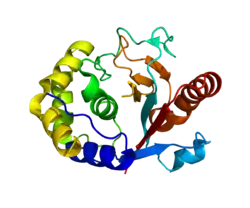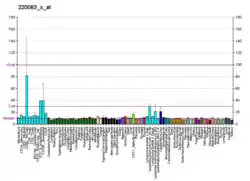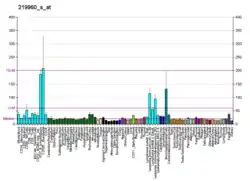Ubiquitin carboxyl-terminal hydrolase L5
Ubiquitin carboxyl-terminal hydrolase isozyme L5 is an enzyme that in humans is encoded by the UCHL5 gene.[5][6][7]
References
- GRCh38: Ensembl release 89: ENSG00000116750 - Ensembl, May 2017
- GRCm38: Ensembl release 89: ENSMUSG00000018189 - Ensembl, May 2017
- "Human PubMed Reference:". National Center for Biotechnology Information, U.S. National Library of Medicine.
- "Mouse PubMed Reference:". National Center for Biotechnology Information, U.S. National Library of Medicine.
- Lai CH, Chou CY, Ch'ang LY, Liu CS, Lin W (Aug 2000). "Identification of novel human genes evolutionarily conserved in Caenorhabditis elegans by comparative proteomics". Genome Res. 10 (5): 703–13. doi:10.1101/gr.10.5.703. PMC 310876. PMID 10810093.
- Wicks SJ, Haros K, Maillard M, Song L, Cohen RE, Dijke PT, Chantry A (Dec 2005). "The deubiquitinating enzyme UCH37 interacts with Smads and regulates TGF-beta signalling". Oncogene. 24 (54): 8080–4. doi:10.1038/sj.onc.1208944. PMID 16027725.
- "Entrez Gene: UCHL5 ubiquitin carboxyl-terminal hydrolase L5".
Further reading
- Maruyama K, Sugano S (1994). "Oligo-capping: a simple method to replace the cap structure of eukaryotic mRNAs with oligoribonucleotides". Gene. 138 (1–2): 171–4. doi:10.1016/0378-1119(94)90802-8. PMID 8125298.
- Suzuki Y, Yoshitomo-Nakagawa K, Maruyama K, et al. (1997). "Construction and characterization of a full length-enriched and a 5'-end-enriched cDNA library". Gene. 200 (1–2): 149–56. doi:10.1016/S0378-1119(97)00411-3. PMID 9373149.
- Hu RM, Han ZG, Song HD, et al. (2000). "Gene expression profiling in the human hypothalamus-pituitary-adrenal axis and full-length cDNA cloning". Proc. Natl. Acad. Sci. U.S.A. 97 (17): 9543–8. Bibcode:2000PNAS...97.9543H. doi:10.1073/pnas.160270997. PMC 16901. PMID 10931946.
- Li T, Duan W, Yang H, et al. (2001). "Identification of two proteins, S14 and UIP1, that interact with UCH37". FEBS Lett. 488 (3): 201–5. doi:10.1016/S0014-5793(00)02436-4. hdl:10536/DRO/DU:30009147. PMID 11163772. S2CID 40717095.
- Strausberg RL, Feingold EA, Grouse LH, et al. (2003). "Generation and initial analysis of more than 15,000 full-length human and mouse cDNA sequences". Proc. Natl. Acad. Sci. U.S.A. 99 (26): 16899–903. doi:10.1073/pnas.242603899. PMC 139241. PMID 12477932.
- Gerhard DS, Wagner L, Feingold EA, et al. (2004). "The status, quality, and expansion of the NIH full-length cDNA project: the Mammalian Gene Collection (MGC)". Genome Res. 14 (10B): 2121–7. doi:10.1101/gr.2596504. PMC 528928. PMID 15489334.
- Rual JF, Venkatesan K, Hao T, et al. (2005). "Towards a proteome-scale map of the human protein-protein interaction network". Nature. 437 (7062): 1173–8. Bibcode:2005Natur.437.1173R. doi:10.1038/nature04209. PMID 16189514. S2CID 4427026.
- Rolén U, Kobzeva V, Gasparjan N, et al. (2006). "Activity profiling of deubiquitinating enzymes in cervical carcinoma biopsies and cell lines". Mol. Carcinog. 45 (4): 260–9. doi:10.1002/mc.20177. PMID 16402389. S2CID 6633207.
- Gandhi TK, Zhong J, Mathivanan S, et al. (2006). "Analysis of the human protein interactome and comparison with yeast, worm and fly interaction datasets". Nat. Genet. 38 (3): 285–93. doi:10.1038/ng1747. PMID 16501559. S2CID 1446423.
- Gregory SG, Barlow KF, McLay KE, et al. (2006). "The DNA sequence and biological annotation of human chromosome 1". Nature. 441 (7091): 315–21. Bibcode:2006Natur.441..315G. doi:10.1038/nature04727. PMID 16710414.
- Yao T, Song L, Xu W, et al. (2006). "Proteasome recruitment and activation of the Uch37 deubiquitinating enzyme by Adrm1". Nat. Cell Biol. 8 (9): 994–1002. doi:10.1038/ncb1460. PMID 16906146. S2CID 25308728.
- Hamazaki J, Iemura S, Natsume T, et al. (2006). "A novel proteasome interacting protein recruits the deubiquitinating enzyme UCH37 to 26S proteasomes". EMBO J. 25 (19): 4524–36. doi:10.1038/sj.emboj.7601338. PMC 1589993. PMID 16990800.
- Qiu XB, Ouyang SY, Li CJ, et al. (2007). "hRpn13/ADRM1/GP110 is a novel proteasome subunit that binds the deubiquitinating enzyme, UCH37". EMBO J. 25 (24): 5742–53. doi:10.1038/sj.emboj.7601450. PMC 1698896. PMID 17139257.
This article is issued from Wikipedia. The text is licensed under Creative Commons - Attribution - Sharealike. Additional terms may apply for the media files.






